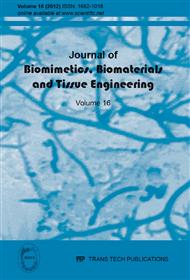[1]
P. Gill, N. Munroe, R. Dua, S. Ramaswamy. Corrosion and Biocompatibility Assessment of Magnesium Alloys. Journal of Biomaterials and Nanobiotechnology, (2012), 3, 10-13.
DOI: 10.4236/jbnb.2012.31002
Google Scholar
[2]
C. K Seal, K. Vince, M. A Hodgson. Biodegradable surgical implants based on magnesium alloys - A review of current research. IOP Conf. Series : Materials Science and Engineering, (2009), 4 (1), 012011.
DOI: 10.1088/1757-899x/4/1/012011
Google Scholar
[3]
Z. Li. Mg/Hydroxyapatite composites for potential bio-medical applications, (2010), Thesis submitted for the degree of M. Phil at the Brunel University.
Google Scholar
[4]
X. Ye, M. Chen, M. Yang, J. Wei, D. Liu. In vitro corrosion resistance and cytocompatibility of nano-hydroxyapatite reinforced Mg-Zn-Zr composites. J Mater. Sci.: Mater. Med., (2010), 21, 1321-28.
DOI: 10.1007/s10856-009-3954-3
Google Scholar
[5]
W. Wacker, A. Parisi, Magnesium metabolism. N. Engl. J. Med., (1968) 278, 712-17.
Google Scholar
[6]
K. W Guo. A Review of Magnesium/Magnesium Alloys Corrosion and its Protection. Recent Patents on Corrosion Science, (2010), 2, 13-21.
DOI: 10.2174/1877610801002010013
Google Scholar
[7]
A. C Hänzi, I. Gerber, M. Schinhammer, J. F Löffler, P. J Uggowitzer. On the in vitro and in vivo degradation performance and biological response of new biodegradable Mg-Y-Zn alloys. Acta Biomater., (2010), 6 (5), 1824-33.
DOI: 10.1016/j.actbio.2009.10.008
Google Scholar
[8]
ASTM G102-89 (1999), Standard Practice for Calculation of Corrosion Rates and Related Information from Electrochemical Measurements. DOI: 10. 1520/G0102-89R99.
Google Scholar
[9]
ASTM G31-72 (2004), Standard Practice for Laboratory Immersion Corrosion Testing of Metals. DOI: 10. 1520/G0031-72R04.
Google Scholar
[10]
L. Xu, E. Zhang, D. Yin, S. Zeng, K. Yang, In vitro corrosion behaviour of Mg alloys in a phosphate buffered solution for bone implant application, J Mater Sci: Mater Med., (2008), 19, 1017-25.
DOI: 10.1007/s10856-007-3219-y
Google Scholar
[11]
P. Gill, N. Munroe. In-vitro corrosion studies of bioabsorbable alloys. In: Magnesium Technology 2012, (eds S. N Mathaudhu, W. H Sillekens, N. R Neelameggham, N. Hort), John Wiley & Sons, Inc., Hoboken, NJ, USA.
DOI: 10.1002/9781118359228.ch87
Google Scholar
[12]
Z. Li, X. Gu, S. Lou, Y. Zheng. The development of binary Mg-Ca alloys for use as biodegradable materials within bone. Biomaterials (2008), 29 (10), 1329-44.
DOI: 10.1016/j.biomaterials.2007.12.021
Google Scholar
[13]
X. B Tian, C. B Wei, S. Q Yang, F.K. Y Fu, P. K Chu. Corrosion Resistance improvement of Magnesium alloy using nitrogen plasma ion implantation. Surf Coat. Technol., (2005), 198 (1-3), 454-58.
DOI: 10.1016/j.surfcoat.2004.10.117
Google Scholar
[14]
Xin Yunchang, Degradation mechanism and surface modification of biomedical magnesium alloy. PhD thesis, City University of Hong Kong, August (2009).
Google Scholar
[15]
Z. Shi, G. Song, A. Atrens. The corrosion performance of anodized magnesium alloys. Corrosion Science, (2006), 48 (11), 3531-46.
DOI: 10.1016/j.corsci.2006.02.008
Google Scholar
[16]
C. O Brubaker, Z. K Liu. A computational thermodynamic model of the Ca-Mg-Zn system. J. Alloys Compd., (2004), 370 (1-2), 114-22.
DOI: 10.1016/j.jallcom.2003.08.097
Google Scholar
[17]
Z. Tao, C. Ding, C. Zhen-Hua: Microstructures and properties of rapidly solidified Mg-Zn-Ca alloys. Trans. Nonferrous Met. Soc. China, 2008, 18, 101-106.
DOI: 10.1016/s1003-6326(10)60183-5
Google Scholar
[18]
B. Feng, J. Y Chen, S. K Qi, L. He, J. Z Zhao, X. D Zhang. Characterization of surface oxide films on titanium and bioactivity. J. Mater. Sci. Mater. Med., (2002), 13, 457-64.
Google Scholar
[19]
J. M Schakenraad, H. C van der Mei, P. G Rouxhet, H. J Busscher. Characterization of eukaryotic cell surfaces prior to and after serum protein adsorption by X-ray photoelectron spectroscopy fibroblasts, HELA epithelial and smooth muscle cells. Cell Biochem. Biophys., (1992).
DOI: 10.1007/bf02782654
Google Scholar
[20]
P. Gill, N. Munroe, R. Dua, S. Ramaswamy. In-vitro Degradation and Cytocompatibility Assessment of Mg-Zn and Mg-Zn-Ca Alloys. Materials and Processes for Medical Devices (MPMD), Aug 8-10, 2011, MN, USA.
Google Scholar
[21]
M. Alvarez-Lopez, M. D Pereda, J. A de Valle, M. Fernandez-Lorenzo, M. C Garcia-Alonso, O. A Ruano, M. L Escudero. Corrosion behaviour of AZ31 magnesium alloy with different grain sizes in simulated biological fluids. Acta Biomaterialia, (2010).
DOI: 10.1016/j.actbio.2009.04.041
Google Scholar
[22]
G. Song, S. Song. A Possible Biodegradable Magnesium Implant Material. Adv. Eng. Mater., (2007), 9 (4), 298-302.
DOI: 10.1002/adem.200600252
Google Scholar
[23]
L. L Li, Y. L Cheng, H. M Wang, Z. Zhang. Anodization of AZ91 magnesium alloy in alkaline solution containing silicate and corrosion properties of anodized films. Trans Nonferrous Met Soc China, (2008), 18 (3), 722-27.
DOI: 10.1016/s1003-6326(08)60124-7
Google Scholar
[24]
G. Song. Control of biodegradation of biocompatible magnesium alloys. Corrosion Science, (2007), 49 (4), 1696-1701.
DOI: 10.1016/j.corsci.2007.01.001
Google Scholar
[25]
B. Zberg, P. J Uggowitzer, J. F Löffler. MgZnCa glasses without clinically observable hydrogen evolution for biodegradable implants. Nature Materials, (2009), 8, 887-91.
DOI: 10.1038/nmat2542
Google Scholar
[26]
M. P Staiger, A. M Pietak, J. Huadmai, G. Dias. Magnesium and its alloys as orthopaedic biomaterials: A review. Biomaterials, (2006), 27 (9), 1728-34.
DOI: 10.1016/j.biomaterials.2005.10.003
Google Scholar
[27]
X. Gu, Y. Zheng, Y. Cheng, S. Zhong, T. Xi. In vitro corrosion and biocompatibility of binary magnesium alloys. Biomaterials, (2009), 30 (4), 484-98.
DOI: 10.1016/j.biomaterials.2008.10.021
Google Scholar
[28]
M. Bodansky. The effect of hydrogen ion concentration on saponin haemolysis. J Biol. Chem., (1929), 82 (3), 567-77.
Google Scholar
[29]
Y. Wang, C. S Lim, C. V Lim, M. S Yong, E. K Teo, L. N Moh. In vitro degradation behaviour of M1A magnesium alloy in protein-containing simulated body fluid. Materials Science and Engineering C, (2011), 31 (3), 579-587.
DOI: 10.1016/j.msec.2010.11.017
Google Scholar
[30]
S. Oh, C. Daraio, L. H Chen, T. R Pisanic, R. R Finones, S. Jin. Significantly accelerated osteoblast cell growth on aligned TiO2 nanotubes. J. Biomed. Mater. Res. Part A, (2006), 78A (1), 97-103.
DOI: 10.1002/jbm.a.30722
Google Scholar
[31]
P. Gill. Assessment of Biodegradable Magnesium Alloys for Enhanced Mechanical and Biocompatible Properties. FIU Electronic Theses and Dissertations, (2012). Paper 714.
Google Scholar


